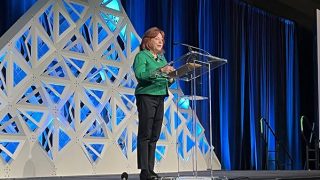Nation Making Progress in Ensuring More Teachers Have Deep Content Knowledge and Mentoring But U.S. Teacher Development Lacks Intensity, Follow-up, & Usefulness
WASHINGTON, D.C. – February 4, 2009 – Every year, nine in 10 of the nation’s three million teachers participate in professional development designed to improve their content knowledge, transform their teaching, and help them respond to student needs. These activities, which can include workshops, study groups, mentoring, classroom observations, and numerous other formal and informal learning experiences, have mixed results in how they effect student achievement.
Research shows that professional learning can have a powerful effect on teacher skills and knowledge and on student learning. To be effective, however, it must be sustained, focused on important content, and embedded in the work of collaborative professional learning teams that support ongoing improvements in teachers’ practice and student achievement.
A comprehensive new report released today by researchers from Stanford University and the National Staff Development Council (NSDC) finds that while the United States is making progress in providing support and mentoring for new teachers and focusing on bolstering content knowledge, the type of support and on-the-job training most teachers receive is episodic, often fragmented, and disconnected from real problems of practice. The report also reviews promising strategies in high-performing nations and U.S. states.
“Teachers lack time and opportunities to view each other’s classrooms, learn from mentors, and work collaboratively,” says Gov. James B. Hunt, Jr., the former four-time governor of North Carolina.
“Most states and districts are still not providing the kind of professional learning that research suggests improves teaching practice and student outcomes,” says Linda Darling-Hammond, Charles E. Ducommon Professor of Teaching and Teacher Education at Stanford University, who wrote the report along with a team of researchers from Stanford’s School Redesign Network. “The research tells us that teachers need to learn the way other professionals do—continually, collaboratively, and on the job. The good news is that we can learn from what some states and most high-performing nations are doing.”
The report is part of a multi-year effort that will track state’s progress over time and identify model policies and practices.
“This first installment provides a baseline assessment of what works and what is happening in states and other nations to provide us with useful benchmarks against which we can measure state and district progress,” says Stephanie Hirsh, executive director of the NSDC, which is sponsoring the research. “Taken as a whole, the effort will be the most comprehensive attempt to measure and monitor what states and districts are doing in professional learning to improve quality and results.”
The multiyear research initiative is funded by the Bill & Melinda Gates Foundation, MetLife Foundation, NSDC, and the Wallace Foundation.
Progress & Challenges
The report – Professional Learning in the Learning Profession: A Status Report on Teacher Development in the U.S. and Abroad – includes analyses of newly available data sources, including the National Center for Educational Statistics’ Schools and Staffing Survey (SASS) database for 2003-04. SASS is a nationally representative sample of more than 130,000 public and private school teachers across all 50 states and the District of Columbia. Researchers also examined the NSDC Standards Assessment Inventory (2007-08), which has been administered to more than 150,000 teachers in more than 5,400 schools across 11 states and one Canadian province. Researchers examined data from 4 states (Alabama, Arizona, Georgia, and Missouri) that had administered the survey statewide.
The report documents some progress but many serious problems in teacher development today:
- Improvement in support for new teachers. According to the report, U.S. public schools have begun to recognize and respond to the need to provide more support for new teachers. Nationally, in 2003-04, more than two-thirds (68 percent) of public school teachers with fewer than five years of experience reported participating in a teacher induction program during the first year of teaching, and 71 percent reported being assigned some kind of mentor teacher. A decade earlier only 56 percent of teachers had experienced teacher induction in their first year of teaching.
- Workshop overload. Research shows that professional development should not be approached in isolation as the traditional “flavor of the month” or one-shot workshop but go hand-in-hand with school improvement efforts. The report finds that teachers still take a heavy dose of workshops and do not receive effective learning opportunities in many areas in which they want help.
- Little intensity, short duration. While rigorous studies indicate that intensive professional development efforts that offer an average of about 50 hours of support a year can make a significant impact on student achievement, raising test scores by an average of 21 percentage points, the majority of teachers in the United States (57 percent) receives no more than about two days (16 hours) of training in their subject areas. Fewer than one-quarter (23 percent) of all teachers receive more than 36 hours of professional learning in their subject areas.
- Working in isolation. U.S. teachers report little professional collaboration in designing curriculum and sharing practices, and the collaboration that occurs tends to be weak and not focused on strengthening teaching and learning.
- Major blind spots. Teachers are not getting adequate training in teaching special education or limited English proficient students. More than two-thirds of teachers nationally had not had even one day of training in supporting the learning of special education or LEP students during the previous three years, and only one- third agreed that they had been given the support they needed to teach students with special needs.
- Lack of utility. Teachers give relatively high marks to content-related learning opportunities, with 59 percent saying this training was useful or very useful. But fewer than half found the professional development they received in other areas, such as classroom management, to be of much value, despite the fact that they want more support in this area.
- Out-of-pocket payments. U.S. teachers, unlike many of their colleagues around the world, bear much of the cost of their professional development. While most teachers were given some time off during the work day to pursue professional learning opportunities, fewer than half received reimbursement for travel, workshop fees, or college expenses.
- Variation in support and opportunity among schools and states. A lower percentage of secondary school teachers reported participating in district-planned professional development than did elementary school teachers. Among states, Arkansas, Connecticut, New Hampshire, and Vermont had significantly higher proportions of teachers participating in professional learning than the national average.
- Limited influence in decision-making. In many high-achieving nations where teacher collaboration is the norm, teachers have substantial influence on school-based decisions, especially in the development of curriculum and assessment, and in the design of their own professional learning. In the United States, however, less than one-fourth of teachers feel they have great influence over school decisions and policies in seven different areas noted in the SASS surveys. A scant majority feel that they have some influence over curriculum and setting performance standards for students, though fewer than half perceived that they had some influence over the content of their in-service professional development. And very few felt they had influence over school policies and decisions affecting either teacher hiring and evaluation or the allocation of the school budget.
What Other Nations Do
The report notes that U.S. teachers participate in workshops and short-term professional development events at similar levels as teachers in other nations. But the United States is far behind in providing public school teachers with opportunities to participate in extended learning opportunities and productive collaborative communities. Those opportunities allow teachers to work together on instructional planning, learn from one another through mentoring or peer coaching, conduct research on the outcomes of classroom practices, and collectively guide curriculum, assessment, and professional learning decisions.
“The United States is squandering a significant opportunity to leverage improvements in teacher knowledge to improve school and student performance,” writes Gov. Hunt in the Foreword to the report. “Other nations, our competitors, have made support for teachers and teacher learning a top priority with significant results. In these countries, students learn and achieve more. Teachers stay in the field longer and are more satisfied with their work. Educators take on even more responsibility for improving what happens in their buildings.”
Data from the Organisation for Economic Co-operation and Development and other sources indicate that other nations provide:
- Extensive opportunities for formal and informal in-service development.
- Time for professional learning and collaboration built into teachers’ work hours.
- Professional development activities that are ongoing and embedded in teachers’ contexts.
- School governance structures that support the involvement of teachers in decisions regarding curriculum and instructional practice.
- Teacher induction programs for new teachers that include release time for new teachers and mentors, and formal training of mentors.
One of the reasons opportunities for teacher development are superior in other nations is that teachers in those countries don’t spend all of their hours in the classroom. U.S. teachers average far more net teaching time in direct contact with students (1,080 hours per year) than any other OECD nation. By comparison, the OECD average is only 803 hours per year for primary schools and 664 hours per year for upper secondary schools. U.S. teachers spend about 80 percent of their total working time engaged in classroom instruction, as compared to about 60 percent for these other nations’ teachers, who thus have much more time to plan and learn together, and to develop high-quality curriculum and instruction.
In most countries, about 15 to 20 hours per week is spent on tasks related to teaching, such as preparing lessons, meeting with students and parents, and working with colleagues. By contrast, U.S. teachers generally have from 3 to 5 hours a week for lesson planning, which is done independently.
Following are some examples of approaches to professional learning that provide lessons for states and the federal government.
- In South Korea – much like Japan and Singapore – only about 35 percent of teachers’ working time is spent teaching pupils. Teachers work in a shared office space during out-of-class time, since the students stay in a fixed classroom while the teachers rotate to teach them different subjects. The shared office space facilitates sharing of instructional resources and ideas among teachers, which is especially helpful for new teachers. Teachers in many of these countries engage in intensive lesson study in which they develop and fine-tune lessons together and evaluate their results.
- In Finland, teachers meet one afternoon each week to jointly plan and develop curriculum, and schools in the same municipality are encouraged to work together to share materials.
- More than 85 percent of schools in Belgium, Denmark, Finland, Hungary, Ireland, Norway, Sweden, andSwitzerland provide time for professional development in teachers’ work day or week, according to OECD.
- In Singapore, the government pays for 100 hours of professional development each year for all teachers in addition to the 20 hours a week they have to work with other teachers and visit each others’ classrooms to study teaching. With the help of the National Institute of Education, teachers engage in collective action research projects to evaluate and improve their teaching strategies.
- England has instituted a national training program in best-practice literacy methods, using videotapes of teaching, training materials, and coaches who are available to work in schools. This effort coincided with a subsequent rise in the percentage of students meeting the target literacy standards from 63 percent to 75 percent in just three years.
- Since 2000, Australia has been sponsoring the Quality Teacher Programme, which provides funding for curriculum and professional development materials used in a trainer of trainers model to update and improve teachers’ skills and understandings in priority areas and enhance the status of teaching in both government and non-government schools.
The experiences of these countries, the report says, “underscore the importance of on-the-job learning with colleagues as well as sustained learning from experts in content and pedagogy. The diversity of approaches indicates that schools can shape professional learning to best fit their circumstances and teacher and student learning needs.”








